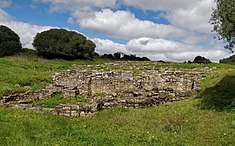Roman villa of Freiria
| Roman villa of Freiria (Villa Romana de Freiria) | |
| Ruins (Ruinas) | |
 | |
| Official name: Villa Romana de Freiria | |
| Country | |
|---|---|
| Region | Lisbon |
| Subregion | Greater Lisbon |
| District | Lisbon |
| Municipality | Cascais |
| Location | São Domingos de Rana |
| - coordinates | 38°43′15.8″N 9°19′23.6″W / 38.721056°N 9.323222°WCoordinates: 38°43′15.8″N 9°19′23.6″W / 38.721056°N 9.323222°W |
| Architects | unknown |
| Style | Roman |
| Material | Granite |
| Owner | Portuguese Republic |
| For public | Private |
| Visitation | Accessible with difficulty |
| Easiest access | Located in the valley between Outeiro and Polima |
| Management | Instituto Gestão do Patrimonio Arquitectónico e Arqueológico |
| Status | Property of Public Interest Imóvel de Interesse Público |
| Listing | Decree 29/90, Diário da República, Série 1, 163 (17 July 1990) |
The Roman villa of Freiria (Portuguese: Villa Romana de Villa Romana de Freiria)) is a Roman villa in the civil parish of São Domingos de Rana, in the Portuguese municipality of Cascais.
History
The villa was constructed in the 2nd century.[1]
First archaeological excavations occurred on site in 1973, by Guilherme Cardoso and professor José d'Encarnação.[1] After work completed between 21 August 1985 and September, the same archaeologists determined that the archaeological site was in fact a Roman villa.[1]
In 1985, excavations unearthed a domus, granary and thermae.[1] Further excavations starting on 13 July 1987, financed by the IPPC, with logistical support from the municipal council and tourism bureau, resulting in the definition of a special zone of the villa fructuária.[1]
Vergílio Correia was the first to identify Roman vestiges in the area, when he discovered a Roman tombstone near the local quarries.[1] The discovery of numerous bell-shaped ceramic fragments document the occupation of this area to a proto-historic phase of settlement between the 2nd 4th century.[1] Among these were: the inferior section a windmill, a dog-like gargoyle with barred teeth, needles and bone pins; iron alloys; bronze needle and a ceramic mold with the decoration of a lion.[1] There are also in southern area of the villa with further 2 metres (6.6 ft) stratigraphic layers of further potential archaeological interest.[1]
Architecture
The site is situated in a rural area surrounded by agricultural lands.[1]
It is constituted by a "villa", with the "domus", of which a few floors have been found in the northeast corner of the peristyle (with a covered patio set on columns, around a garden) with a marble column base and fallen capital, and an "impluvium" (square opening in the middle of the atrium that collected rainwater.[1] In the thermae is a water tank, with stones detected suggesting a possible buttress supporting the wall of the tank, possibly being a "natatio" that would simultaneously serve the northern thermal complex and the needs of the villa fructuária.[1]
The surrounding agricultural area includes rural structures such as a barn and winery.[1] The granary, which is large and extremely well built, has buttresses distributed along the northern and eastern foundation corridors, indicating a walled courtyard that used natural slab flooring.[1] Also along the southern edge was an area expressly designed for an earthen oven to bake bread and an altar in honor of Triborunis (an indigenous divinity).[1]
References
Notes
Sources
- "Outeiro de Polima - Sondagens arqueológicas no Casal de Freiria", Jornal da Costa do Sol (in Portuguese), Cascais, Porutgal, 29 August 1985, p. 15
- "Ruínas Arqueológicas em Casal Freiria", Boletim da Junta de Freguesia de S. Domingos de Rana (in Portuguese), 30 August 1985, pp. 1–2
- "Surpreendentes descobertas em Freiria", Jornal da Costa do Sol (in Portuguese), 14 August 1986, pp. 1/6
- Cardoso, Guilherme (1986), Cascais no tempo dos romanos (Exposição) (in Portuguese), Cascais, Portugal
- Antunes, Cristina (18 August 1988), "Visita à Villa Romana de Freiria", Jornal da Costa do Sol (in Portuguese) (1059) (XXIV ed.), p. 8
- Cabral, João Pedro (1988), "Nota sobre o topónimo Freiria", Arquivo de Cascais (in Portuguese) (7), pp. 45–55
- Cardoso, Guilherme; Encarnação, José d' (1994), "Villa Romana de Freiria", Informação Arqueológica (in Portuguese) (9), Lisbon, Portugal, pp. 60–61